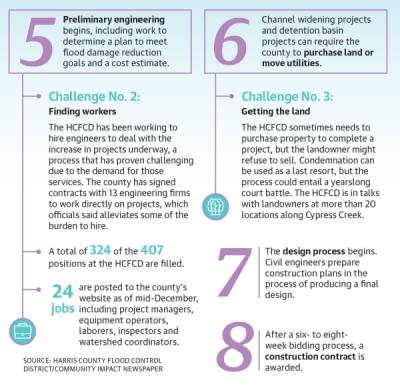With $2.5 billion in local money at its disposal courtesy of a bond referendum approved by voters in August 2018—$291 million of which is allocated for the Cypress Creek watershed—HCFCD Deputy Executive Director Matt Zeve said construction is only beginning to ramp up in the Spring and Klein area.
The district had 13 active construction sites in the community as of mid-December, and there are plans for 17 capital and bond-funded projects and 42 maintenance and storm repair projects in the area over the next decade.
In August 2017, Hurricane Harvey saturated the Texas Gulf Coast, causing Cypress Creek to pour out of its banks and flood roughly 11,000 homes in Precinct 4 in addition to numerous businesses, churches and other community resources. Nearly 30 months later, residents of Spring and Klein are anxious to find flood relief in the coming year.
“We have over 250 active construction sites right now, and we’ll have that many, if not more, in 2020,” Zeve said. “We have a lot of construction that will begin in 2020 in the Cypress Creek watershed. We had our biggest spending year in history—approximately $300 million [in 2019]—and we look to do even more in 2020, possibly even doubling that.”
Despite this progress, Zeve said even in ideal conditions the district’s efforts will not be enough to meet a request made by elected officials earlier this year to cut the 10-year timeline to complete bond projects in half.
“We did complete a very in-depth investigation about the feasibility of completing the entire bond program in five years, and ... that study revealed that under perfect circumstances ... we can complete the bond program [in] probably closer to nine years,” Zeve said.
As pressure from the public continues to build with every impending hurricane season, Zeve said HCFCD is working to complete projects as efficiently as possible while overcoming staffing shortages and external challenges that can lead to delays.
Project progress
Since Hurricane Harvey, HCFCD has acquired 80 properties in the Cypress Creek watershed, in addition to three tracts of land for flood plain preservation, 10 tracts of land for stormwater detention basins and 105 empty tracts of land that were platted for houses, Zeve said.
As of mid-December, the district was also in the process of acquiring 60 additional properties and 48 tracts of land in the Cypress Creek watershed. In total, HCFCD had property rights for over 10,278 acres in the Cypress Creek watershed at that time.
“Unfortunately, a lot of the Cypress Creek watershed was developed before we had a firm understanding of where we should and shouldn’t build safely,” he said. “But what’s done is done, so now, we’re working to solve some of those problems through buyouts.”
While Zeve said he could not comment on the precise locations of buyout areas of interest, he noted there were several in the Spring and Klein area, including potential stormwater detention sites near Cypress Creek and Stuebner Airline Road.
Likewise, Jill Boullion, executive director of the Bayou Land Conservancy, a nonprofit that works to preserve land in the Greater Houston area, said her organization was also in talks with landowners in the Cypress Creek watershed regarding land acquisition for flood plain preservation. While Boullion said she could not disclose any details on these efforts, she hoped she would be able to announce some acquisitions once they had been finalized in 2020.
On the horizon
While HCFCD already has several local projects under construction—including a $2.8 million project to address erosion on Spring Gully—Zeve said several more will begin in 2020, including a $60 million bond-funded project that will provide major maintenance along Cypress Creek.
According to Zeve, the project will address erosion and remove sediment along the channel to ensure it functions at its maximum capacity. The project is slated to go out for bid in January, and construction will likely begin three months thereafter, wrapping up by spring 2021.
“The flood control district, in the past, hasn’t had the funding to do all of the maintenance of all of our infrastructure,” Zeve said. “So we actually put this on the bond program because Cypress Creek has such a large backlog of maintenance that we wanted to use this as an opportunity to address that.”
Additionally, Zeve said a contract was just awarded for a $2.2 million bond project that will perform maintenance and restore channel capacity on Pillot Gully, which runs through The Vintage area. Construction on that project is expected to begin this spring.
“[Spring and Klein residents] can also look forward to seeing some activity on the southeast corner of TC Jester and Cypresswood Drive [in 2020],” Zeve said. “The flood control district already owns this [land], and we plan to get started on the first steps to build a detention basin at that location.”
In addition to projects in the upper Cypress Creek watershed that will take shape in 2020, another project the HCFCD will see results from this year is the update to the 2003 Texas Water Development Board’s Regional Drainage Plan and Environmental Investigation for Major Tributaries in the Cypress Creek Watershed.
According to Zeve, the update will help HCFCD pinpoint areas where staff should be acquiring right of way before they can begin on the next phase of bond projects. The update should be released to the public in February.
Outside of the bond, the Bayou Land Conservancy board approved its 20-year Strategic Conservation Plan in November. Boullion said the plan identified 26,500 acres of high-quality land in the Cypress Creek watershed that would be desirable for future flood plain preservation—about 10% of the total acreage in the watershed.
“Our goal is to double our conservation acres. So we could go from where we are now, at about 14,000 [acres], up to 20,000-30,000 [acres] in the next 20 years,” Boullion said. “So it’s a big goal. ... It would be a really positive impact because it’s all flood plain preservation, [which means] flood mitigation, drought resilience, improved water quality and connected green spaces.”
Boullion said the organization will spend much of 2020 speaking to the community about how it can support the conservation efforts outlined in the strategic plan.
Likewise, Joe Stinebaker, director of communications for Harris County Precinct 4, said flood prevention is one of Precinct 4 Commissioner Jack Cagle’s top priorities going into 2020, if not the top priority.
“We no longer can afford the luxury of hoping that we’re not going to be hit with a catastrophic storm,” Stinebaker said. “If we’ve learned anything over the last five, 10 years, it’s that we are going to be hit with a catastrophic storm, and it’s now our job to prepare for it.”
Challenges persist
With big plans for 2020, Zeve said addressing challenges, such as the staffing shortage the district has faced throughout 2019, will be key in expediting the bond process.
As of mid-December, HCFCD had filled 324 of 407 total positions in the district with 24 jobs posted on its website, ranging from construction workers to division heads. By comparison, in May, the HCFCD had filled 328 of 374 total positions with 14 jobs posted on its website.
“Any time the oil and gas industry is doing well, it’s great for our region, but you also pull a lot of people, both engineer and support people, away from other types of engineering,” said Jeff Collins, executive vice president of LJA Engineering, a Houston-based firm that has contracted with Harris County on multiple drainage and flood projects.
To keep up with the growing demand, Zeve said HCFCD has staff contracts with 13 engineering consulting firms to fill in staff as needed.
Zeve added that external challenges outside of the district’s control—including delays from environmental permitting, right of way acquisition, utility adjustments and the weather—will also be crucial to the completion of HCFCD’s bond projects over the next decade.
Despite these challenges, Zeve said he is already looking beyond 2020 to 2021 and 2022, which he said he suspects will be the biggest construction spending years in the entire bond program.
“Once we get to a point where a significant portion of these flood bond projects have been completed and the residents of Harris County can see just how successful they’ve been, then, the community can come together and discuss whether or not they want to pay for yet even more to be done,” Stinebaker said.
Shawn Arrajj contributed to this report.








